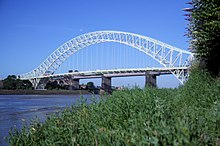Silver Jubilee Bridge
| Silver Jubilee Bridge | |
|---|---|

Silver Jubilee Bridge
|
|
| Coordinates | 53°20′48″N 2°44′16″W / 53.3466°N 2.7377°W |
| Carries | Road traffic and pedestrians |
| Crosses |
River Mersey Manchester Ship Canal |
| Locale | Runcorn Gap between Runcorn and Widnes |
| Other name(s) | Runcorn Bridge, Runcorn-Widnes Bridge |
| Maintained by | Halton Borough Council |
| Characteristics | |
| Design | Through arch bridge |
| Material | Steel |
| Total length | 527 yards (482 m) |
| Width | 18 yards (16 m) |
| Height | 285 feet (87 m) |
| Longest span | 361 yards (330 m) |
| No. of spans | 1 |
| Clearance below | 80 feet (24 m) over the Manchester Ship Canal |
| History | |
| Designer | Mott, Hay and Anderson |
| Construction begin | 25 April 1956 |
| Opened | 21 July 1961 |
| Statistics | |
| Daily traffic | Over 80,000 |
| Toll | Not currently |
Coordinates: 53°20′48″N 2°44′16″W / 53.3466°N 2.7377°W
The Silver Jubilee Bridge or Runcorn Bridge crosses the River Mersey and the Manchester Ship Canal at Runcorn Gap between Runcorn and Widnes in Halton, England. It is a through arch bridge with a main arch span of 361 yards (330 m). It was opened in 1961 as a replacement for the Widnes-Runcorn Transporter Bridge, and was initially known simply as the Runcorn Bridge or Runcorn–Widnes Bridge. In 1975–77 it was widened, after which it was given its official name in honour of the Queen's Silver Jubilee. It carries the A533 road and a cantilevered footway. The bridge is recorded in the National Heritage List for England as a designated Grade II listed building.
Until 1868, when Runcorn Railway Bridge was opened, the only means of crossing the Mersey at or near Runcorn Gap were by fording or by ferry. Before that the lowest crossing of the river had been the road bridge at Warrington. The first bridge to carry vehicular traffic across Runcorn Gap was the Widnes-Runcorn Transporter Bridge which opened in 1905. This was an inefficient means of transport and it had become inadequate for the amount of traffic using it before the outbreak of the Second World War. In 1946 the Ministry of Transport agreed that the transporter bridge should be replaced when sufficient funds were available. Mott, Hay and Anderson were appointed as consultant engineers.
...
Wikipedia
